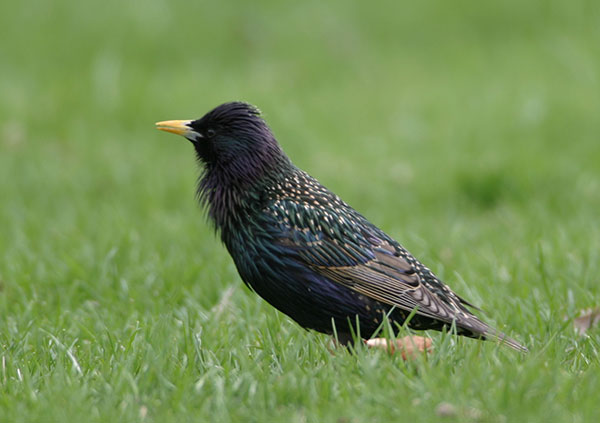The European Starling (Sturnus vulgaris) is a chunky, glossy black bird with small white spots, a short tail, and a sharp beak.
This blackbird-sized, gregarious bird lives in edge, open, and urban habitats in Alaska south through most of Canada, the USA, and northern Mexico.
If you see a flock of dark birds with short tails perched on roadside wires or on the ground in a park or lawn, they might be European Starlings. In many places, this species is one of the most common and easily seen birds.
On this page
Identification
The European Starling is a rather chunky, short-tailed bird with long pointed wings, and a longish, sharp beak. Males in breeding plumage are black birds with glossy purple and green highlights.
They have small pale spotting on their body, rusty edging on their wings, and a yellowish beak. On average, these birds are 8.5 inches long, have a 16-inch wingspan, and weigh 2.9 ounces.
Breeding female European Starlings look like males but usually have more spotting on their head and body. In spring and summer, the feathers on the head and chest of both sexes also have a peculiar, hair-like appearance.
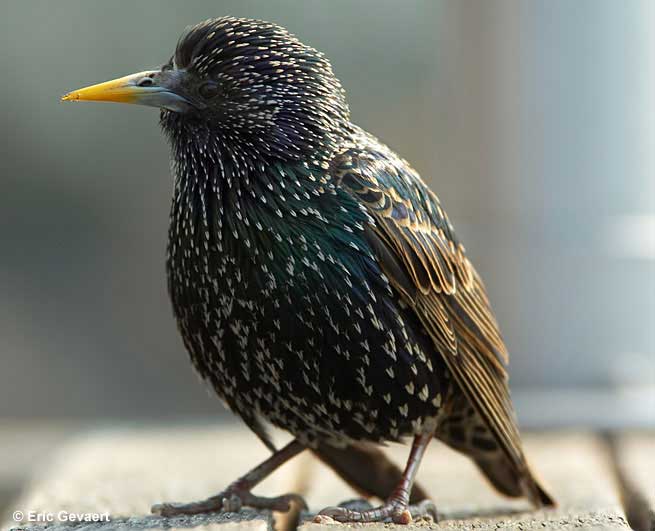
This species also has long, pinkish legs and a distinctive, triangular shape as it quickly flies with rapid wing beats and brief glides.
In winter, both male and female European Starlings are heavily spotted, duller black, have a bit of black in front of their eyes, and more rusty edging in their wings. They also have black beaks, and young birds are plain gray birds with a pale throat.
The male European Starling has an impressive complex song that includes whistles, chattering, electronic-sounding noises, and mimicry. Females also sing but not as loudly or as long as males.
Food
European Starlings are adaptable birds that eat a wide variety of invertebrates, fruits, seeds, grain, and even garbage. Although they will feed on most invertebrate they find, starlings seem to prefer beetles, flies, butterflies, worms, snails, spiders, and millipedes.
These birds forage in flocks a lot like grackles and other blackbirds. They walk on lawns, muddy farm fields, and other areas with bare ground or short grass, and use their beaks to snatch food from the ground.
They will pick up worms and other bugs as soon as they see them but typically use their beaks to probe into the ground or move bits of dirt.
Like blackbird species, after sticking their sharp beaks into the ground, they open their bills to move the dirt and reveal hidden arthropods.
While foraging for bugs, they also pick up seeds and grain, especially during the fall and winter when there aren’t as many arthropods available.
Starlings can also sally into the air to catch insects but mostly find them on the ground. When feeding on fruit, flocks perch in a bush or tree and pick the berries off branches with their beaks. Much to the chagrin of some birders, these smart birds are also regular at feeders.
Nesting and Eggs
In spring, European Starling start the breeding season with males looking for nesting sites. The male birds look for cavities in trees and cavity-like structures on buildings and other situations. They put some nesting material in one or more of these possible sites and show them to their mate.
Once the female settles on a nest cavity, she and her mate make a shallow cup nest out of bits of soft bark, grass, and other soft materials in the bottom of the hole.
When the nest is ready, the female bird lays five pale blue eggs that are 1.14 inches long. She does most of the incubation, especially at night, but the male also helps out a little bit.
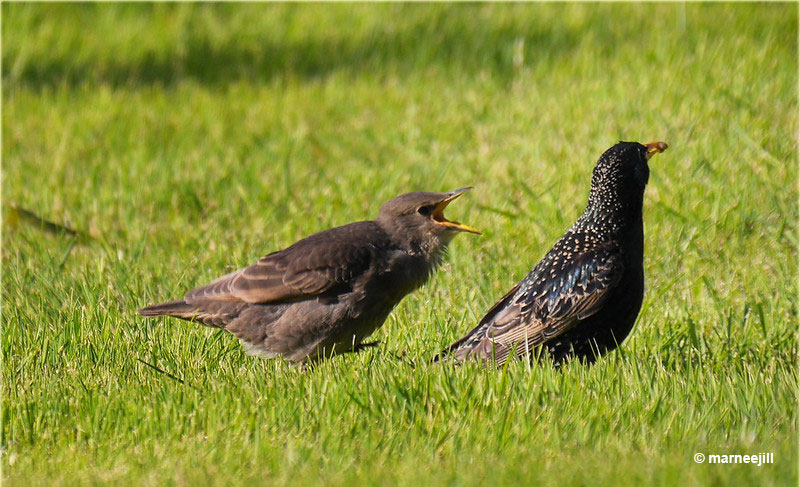
After 12 days of incubation, the eggs hatch and both parents brood the baby starlings for a week. During that time, both parents also feed their nestlings soft invertebrates.
As they grow, their parents bring them larger food items, and the young birds leave the nest around three weeks after hatching.
One or two days after leaving the nest, the baby starlings can find food for themselves but are occasionally fed by their parents for ten or twelve more days. By that time, they flock with other starlings and fend for themselves.
Current Situation
European Starlings are found in parts of Alaska, much of Canada, all of the lower 48 states, and northern Mexico.
In their native range, they live in Europe, and parts of Asia, North Africa, and the Middle East.
They have also become established in some other parts of the world. No matter where they occur, this species lives in urban areas, farms, parks, and other semi-open habitats.
European Starlings are listed as Least Concern in the IUCN Red List and are one of the most common bird species in the world.
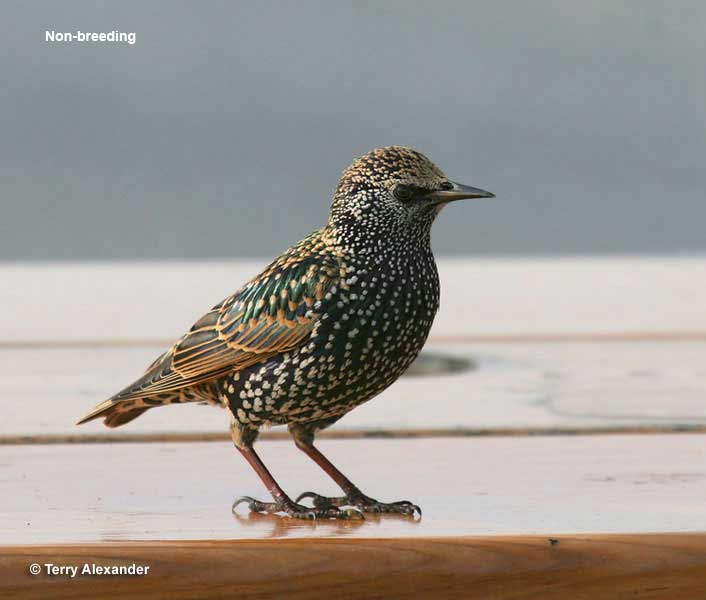
Unlike many other birds, this species is abundant and benefits from people, especially in North America.
Unfortunately, it can displace Red-headed Woodpeckers and other species that it competes with for nesting sites. In Eurasia, although still common enough, intensive farming practices have caused declines in European Starlings in some areas.
Facts
- European Starlings are one of the few bird species that use their sense of smell to find food. While foraging for insects, they use their sense of smell to find some prey items on lawns and open fields. Farmers have taken advantage of this adaptation by using repellents to keep starlings away from grain fields.
- After breeding, this species can form huge flocks that fly together in artistic synchronized flight. Such moving and mesmerizing flocks of starlings are known as “murmurations”.
- Incredibly, all of the 200 million European Starlings that live in North America are descended from just 100 birds! In the 1890s, some misguided but well-intentioned people wanted to have all of the birds mentioned in Shakespeare’s works also occur in North America. To help make that happen, they released 100 of them in New York’s Central Park. In the absence of similar competitors, European Starlings quickly became an established and common species.
- This species is an excellent mimic. In its songs, we can often hear bits of Killdeer, American Robin, and Northern Flicker songs. They can also be trained to mimic human speech!
- Although many people regard this species as a pest, European Starlings eat lots of insects that would otherwise damage crops and trees.
Similar Species
The European Starling has a pretty unique appearance but could be possibly confused with a few other species.
Brewer’s Blackbird
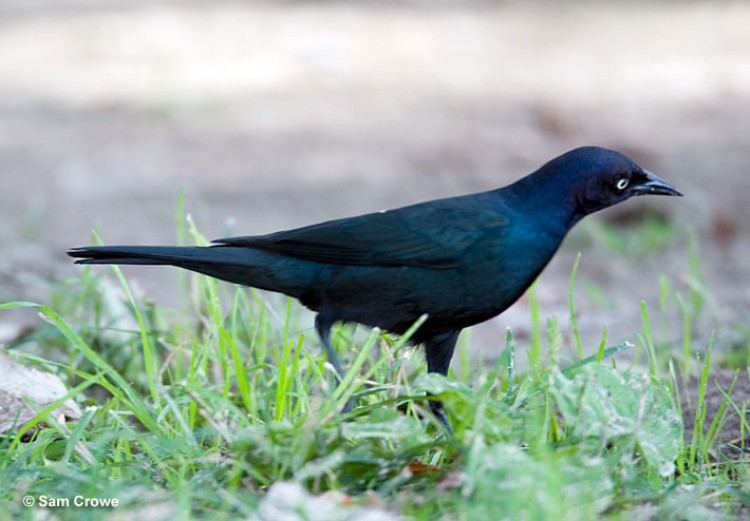
The Brewer’s Blackbird is similar in size to the European Starling, has dark plumage, and also forages on lawns and other open habitats. However, it lacks the spots shown by starlings, has a longer tail, and a stouter beak.
Brown-headed Cowbird
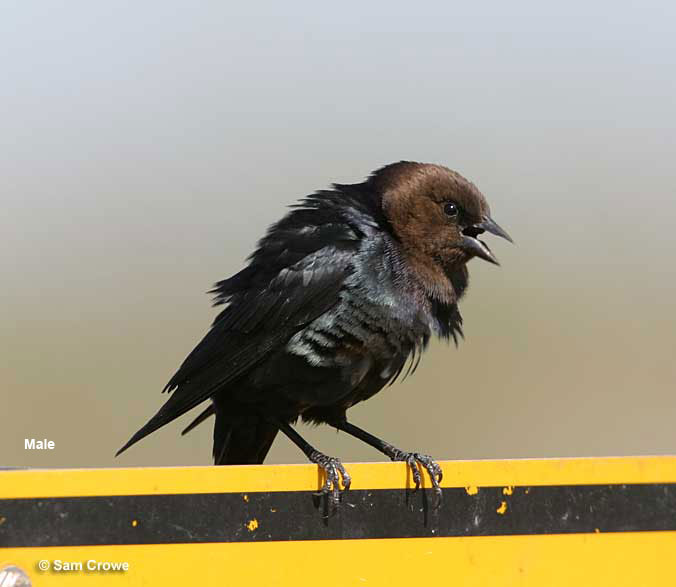
The Brown-headed Cowbird is another species that can be found in the same open habitats as the European Starling, and they also have a rather short tail.
However, cowbirds have a dark brown head, lack pale spotting, and have a more finch-like beak.
Red-winged Blackbird
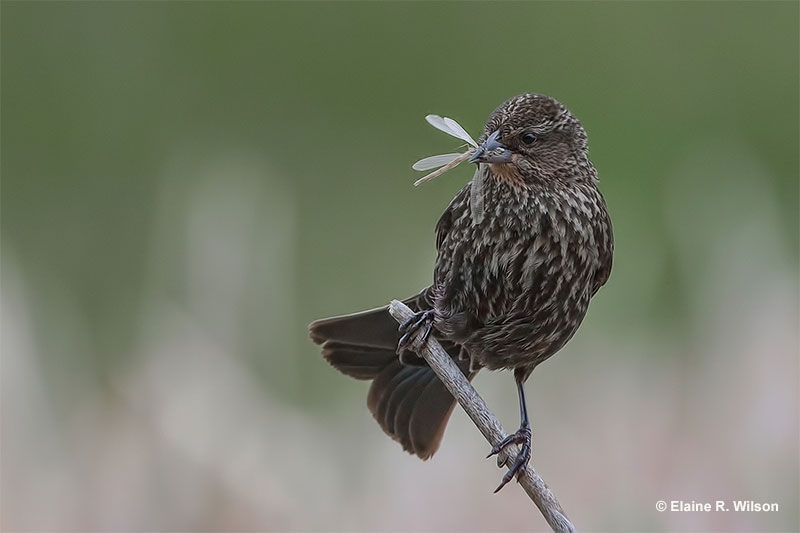
Female Red-winged Blackbird
Although the male Red-winged Blackbird is distinctive, females could possibly be confused with winter-plumaged European Starlings.
Like starlings, they have rusty coloration on their wings and also have lots of pale markings.
However, female Red-wings Blackbirds are streaked and not spotted, have a different head pattern, and may show a bit of red in their shoulders.
Frequently Asked Questions
Why are they called starlings?
Starlings are called “starlings” because their dark plumage with small white spots resembles a star-filled sky. They might also get their name from their triangular, star-like shape in flight.
Are European Starlings friendly?
European Starlings are not particularly friendly. They don’t attack people or pets but will take over nests of native birds and are wary of people.
Are starlings a problem in the US?
In many places, starlings are a problem in the US. Their large populations can damage grain, and they aggressively compete with native birds for nest sites.
How did European Starlings get to the US?
European Starlings came to the US when they were released in New York’s Central Park in the 1890s.

